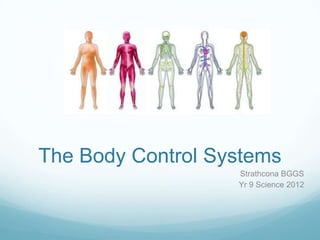
Body control systems nervous system
- 1. The Body Control Systems Strathcona BGGS Yr 9 Science 2012
- 2. The Body Control Systems You are made up of somewhere between 50 000 000 000 000 – 75 000 000 000 000 (50 – 75 Trillion cells1. To maintain and control all of these we have a number of systems this year we will look at 2 of these. 1. Asimov, Isaac, The Human Body, New Rev Ed. p 79
- 3. In this Unit We will look at two systems involved in the control of the Human Body: 1. The Nervous System 2. The Endocrine System Consists of tissues that Consists of glands that produce conduct electrical signals chemical messages (Hormones). (nerve impulses) Hormones travel through the Impulses travel at high speed blood stream. Generally brings about fast, Generally brings about slow, long short term change term change
- 5. 1.The Nervous System It is our interface to the outside world. Is made up of 2 parts: a) The Central Nervous System (CNS) which is made up of the Brain and Spinal Cord. b) The Peripheral Nervous System (PNS)
- 6. Neurons are the cells that carry nerve signals around the body All Neurons have the same basic structures: Dendrites: (from the Greek meaning tree) branched extension of nerve cells that receive nerve impulses from other cells. Cell Body (including a nucleus) Axon: a long, slender projection that conducts electrical impulses away from the neuron's cell body. NB: Neurons are some of the oldest and longest cells in your body. You have many of the same neurons for your whole life.
- 7. Axons & Dendrites Axon Dendrites Take information away from Bring information to the cell the cell body body Smooth Surface Rough Surface (dendritic spines) Generally only 1 axon per cell Usually many dendrites per cell No ribosomes Have ribosomes Can have myelin No myelin insulation Branch further from the cell body Branch near the cell body
- 12. Is made up of 4 different types of neurons; we will deal with 3 : 1. Brain Cells – These process information. 2. Sensory Neurons – These detect the outside world and send signals to the CNS 3. Motor Neurons – These receive signals from the CNS and pass them on to muscles and glands.
- 13. Our Sensory Neurons receive or detect information from specialised cells. This is then sent to the CNS for processing. CNS From the CNS commands are sent to Motor Neurons in the PNS which pass them on to muscles and glands. Sensory NB: Nerves only carry signals in one direction Neurons Motor Neurons PNS
- 14. Synapses: a small gap separating neurons. Signals travel through a nerve as an electrical signal but across synapse as a chemical signal or neurotransmitter.
- 15. Stimulus - Response A Stimulus is any change in the environment of the organism. The nervous system will then induce a response, which may be movement, speech, blinking etc. Advanced organisms have specialised sense organs, which are designed to detect stimuli. These are often called receptors and are sensitive to one stimuli (e.g. Skin to touch, eyes to light patterns) A Response is how the organism reacts to the stimulus and results in a change in behaviour Examples Stimulus: being cold - Response: move into the sun Stimulus: Thirst - Response: Get a drink
- 16. The Reflex Arc A reflex is the simplest form of response to a stimulus. In a reflex reaction, the response occurs before the message reaches the brain, or the message may not reach the brain at all. The receptor cell sends an impulse through a sensory neuron to the spinal cord. The message doesn’t go directly to the brain but to the cell body of motor neuron and then to the muscle. The muscle contracts and the response is issued. The brain may get the message soon after. In reflexes, the impulse is not related to stored information in the brain before the response. The most common reflex is the knee jerk.
- 17. Remember: Information travels through the neurones as an electrical impulse. Nerve impulses travel in only one direction in a nerve fibre. (Dendrites Axon) Information is passed between neurones as chemical messages.
- 18. Reference: Work to be completed: Science Links 3 Textbook: 7.1 Nerves and reflex Action p 193 – 1, 2 & 4 pp191 – 196 p 196 – 1, 3-4, 6-8, 10 Homework Book: p 94 Activity 8.1 pp 95-6 Activity 8.2
